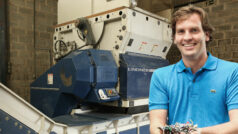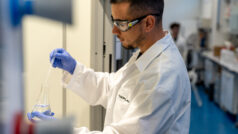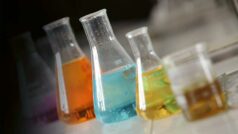To sustain the rapid growth of novel technologies, the demand for certain mineral resources and critical raw materials (CRMs) has grown rapidly. On a global scale, there are now twice as many raw material extractions as there were in the 1990s. Raw material exploitation must satisfy current needs, which in 2019 amounted to the equivalent of 14 tonnes of raw materials per European citizen, 0.7 tonnes of which corresponded to metals. By 2040, a 40% increase in raw material extraction is estimated. Transition to climate neutrality requires a strategy that ensures the long-run sustainability of the supply of valuable raw materials. A thorough review of all geological resource extraction activities on the planet is needed to ensure guarantee their social, environmental and economic sustainability. The EU has therefore created a list of CRMs which is subject to regular review and updating. CRMs include raw materials of great importance to the EU economy and those subject to high supply risk.
Fifth List of Critical Raw Materials (CRM) for the EU, 2023.
| Bauxite | Coking Coal | Lithium | Phosphorus |
| Antimony | Feldspar | Light rare-earth elements | Scandium |
| Arsenic | Fluorspar | Magnesium | Silicon metal |
| Baryte | Gallium | Manganese | Strontium |
| Beryllium | Germanium | Natural Graphite | Tantalum |
| Bismuth | Hafnium | Niobium | Titanium metal |
| Boron/Borate | Helium | Platinum-group metals | Tungsten |
| Cobalt | Heavy rare-earth elements | Phosphate Rock | Vanadium |
| Copper | Nickel |
Plenty of electrical and electronic equipment is discarded at its end of life and its valuable and potentially reusable materials are lost. Until recently, recycling capabilities for waste electrical and electronic equipment (WEEE) were limited to its removal. Traditional mechanical processes were not able to separate the components with enough precision and purity. WEEE therefore ended up in landfills with no chance of recovery WEEE constitutes a secondary source of CRMs and other valuable materials. In some WEEE, CRMs may be found at higher concentrations than in natural ores. The elemental composition of WEEE is highly variable and complex. Based on the elemental composition of WEEE, two of the types of waste are lithium-ion batteries (LIBs), which contain Li and Co, and printed circuit boards (PCBs), which contain Si and platinum-group metals. Demand for LIBs in particular has increased exponentially due to the needs of the portable electronics and electric vehicle industries. Developing recycling technologies for all WEEE constituent materials is of great importance to protect the environment and reduce the extraction of scarce metals and the environmental and energy impact of extraction. This article will focus on current and emerging recycling technologies aimed at recovery of CRMs from WEEE, especially LIBs and PCBs.
Mechanical pretreatment
WEEE is complex waste. For example, LIBs are used in many different applications, including household items and electric vehicles, which results in a wide variety of designs that differ in their capacity, shape, size and composition. Likewise, the morphology PCBs also varies depending on the application. Due to this heterogeneity, it is necessary to establish different collection and sorting systems, as well as mechanical pretreatments, to ensure a homogeneous waste stream that facilitates the implementation of recycling processes. Despite the disparity in waste types, some information can be provided on the mechanical pretreatments needed prior to CRM recovery processes.
Mechanical pretreatment aims to enrich the metallic fraction and reduce waste volumes and energy consumption. Grinding is generally carried out in the first step of the process to reduce particle size. In the case of LIBs, preliminary deactivation of the battery is required to minimize risks during handling. The ground material then undergoes magnetic and/or density separation processes: eddy-current technologies are implemented to separate the metallic fractions and a densimetric table separator is used to separate the plastic fraction. Grinding, sieving, separation and classification cycles can then be carried out to achieve smaller particle size and purer fractions. The end product of mechanical pretreatment is a fine solid fraction rich in CRMs and other valuable metals, which can be recovered via chemical- and bio-based procedures.
Hydrometallurgy
Chemical-based recycling of valuable metals by hydrometallurgy involves leaching, which dissolves the solid-metal fraction and results in a recycled metal solution for further separation. Typical leaching agents include inorganic/organic acids, alkaline solutions and ammonia-ammonium salt systems. In hydrometallurgy processes, the metal waste is placed in direct contact with the leaching solution. The main goal of the leaching process is to obtain as much dissolution of the target metal with high solid content using the least energy and reagent consumption. The leaching process is affected by several factors such as reaction time, temperature, solid-liquid ratio and leaching agent concentration and type. Strong mineral acids such as hydrochloric acid (HCl), sulfuric acid (H2SO4), nitric acid (HNO3) and phosphoric acid (H3PO4) have shown high leaching efficiencies. They are used in conjunction with reducing agents such as hydrogen peroxide (H2O2), sodium bisulphite (NaHSO4) and glucose (C₆H₁₂O₆).
With HCl, H2SO4 and HNO3, dissolution percentages close to 100% for Li and Co from LIBs have been obtained. The same is true for Ni, Cu and Mn from PCBs. Process conditions must be optimized based on the chemistry of the target waste, but generally involve temperatures between 70ºC and 90ºC and short reaction times ranging from minutes to a few hours. Despite its effectiveness, acid leaching results in highly acidic wastewaters, as well as Cl2, SO2, NOx and other harmful gas emissions, making it difficult to implement the process.
Ionic liquids (IL) have emerged as an alternative to traditional solvents. The use of hydrophobic ILs at room temperature could be a step towards safer solvent extraction processes. However, ILs are still expensive and the economic viability of the process must be thoroughly studied. Another alternative are deep eutectic solvents (DESs), a new class of tailor-made solvents. The mixture of two compounds heated to the eutectic point of mixing gives a liquid at room temperature that shares common properties with conventional ILs and offers the opportunity to adjust the physicochemical properties of the liquid obtained by selecting from a wide spectrum of molecules. However, unlike ionic liquids, the synthesis of deep eutectic solvents is cheap and easy, and there is no need to purify the product obtained. DESs are also generally less water soluble and less viscous than ILs due to their ionic character. These properties are advantageous in the context of solvent extraction of metal ions.
The main advantage of traditional hydrometallurgy is that it is applicable to all types of pretreated WEEE waste, thus making it an efficient, flexible process that can produce highly pure extracted metals. However, its high associated environmental impact involving the formation of large volumes of acidic wastewater call for capital investment for wastewater treatment.
Bioleaching
Bioleaching is a natural process carried out by microorganisms in which insoluble metals are solubilized. This process constitutes a novel biotechnological alternative with less environmental impact than traditional processes for recycling WEEE. Microorganisms associated with bioleaching are generally acidophilic iron-oxidizing bacteria (i.e. Acidithiobacillus ferrooxidans) or sulphur-oxidizing bacteria (i.e. Acidithiobacillus thiooxidans). These bacteria use ambient CO2 as a carbon source and inorganic compounds such as ferrous ion and reduced sulphur as an energy source. From a chemical standpoint, bioleaching reactions can be broadly classified as follows:
- Acidolysis: metal transformation from insoluble to soluble occurs by the bio-acids and/or protons produced by the microbe.
- Redoxolysis: metal solubilization is triggered by electron transfer between the solid metal waste and the microbes in contact with the surface of the metal.
Bacterial bioleaching can be carried out with a single acidophile or a consortium of acidophiles. It is a complex process in which many factors affect the efficiency of metal dissolution: the microorganism used, composition of the leaching medium, pulp density, temperature, catalysts and metallic waste particle size. Another important consideration is the bioleaching approach. Based on interaction between the microorganism and the metal waste, bioleaching processes can be classified into:
- One-step bioleaching: metal waste is added to the microbial culture from the start. Leaching occurs as microbial growth progresses. One-step bioleaching is often hindered by the toxic effects of metals on microorganisms.
- Two-step bioleaching: microorganisms are grown until the stationary phase and metal waste is then added. This minimizes the toxic effects of metals on microbial growth and facilitates metal extraction.
- Spent-medium bioleaching: there is no direct contact between the microorganism and metal waste. In the first stage, the microorganism is cultured. When growth is complete, the cells are removed. Metal waste is then added to the cell-free medium, which contains organic acids.
Spent-medium bioleaching is the most preferable approach, given that leaching efficiencies are usually higher. Furthermore, the spent-medium method can be applied to waste containing toxic components (i.e. organic solvents from spent LIBs). In contrast, the one-step and two-step methods generally require the microorganism’s adaptation to the toxicity of metals and/or other products present in the sample. The spent-medium approach also provides for optimization of individual biological and chemical processes. Microbial growth and biogenic acid production can be optimized in the first step while chemical leaching conditions can be adapted to separately. Bioleaching has been successfully applied to recover valuable metals from two main waste streams: waste printed circuit boards (PCBs) and spent lithium-ion batteries (LIBs). In the case of spent LIBs, over 90% recovery of Li, Co, Mn and Ni has been achieved. CRM recovery efficiencies are also high when working with PCBs: Cu, Al, Ni and Zn have also been recovered with an efficiency greater than 90%. As mentioned above, research shows the need to optimize the process based on the targeted waste type and microbial agent used. For example, adapting the medium composition can increase Co dissolution from 44% to 94%. Besides acidophilic bacteria, fungi can also be used in bioleaching. Although several species have been studied, Aspergillus niger is favoured due to its ease of cultivation and higher bio-acid yields. Heterotrophic fungi grown on carbon sources produce biogenic acids (citric acid, malic acid, gluconic acid and oxalic acid) that drive the dissolution of metals mainly through acidolysis reactions. As with bacterial bioleaching, optimization of process conditions allows for extraction efficiencies greater than 95% for Li, Co, Mn, Ni and Zn from LIBs and PCBs. Research has shown that spent media containing bio-acids yields greater metal extraction than synthetic acids. Fungal bioleaching is an interesting alternative to be explored because an extra circular economy step can be included: organic waste can be used as the carbon source for fungal growth.
Bioleaching is a promising biotechnological tool for resource recovery. Table 2 contains the main advantages and disadvantages of bioleaching compared to traditional hydrometallurgy.
Table 2. Advantages and disadvantages of bioleaching.
| Advantages | Disadvantages |
| Environmentally sustainable | Slow process kinetics |
| Low cost of operation and energy requirement | Long processing time |
| Minimal use of strong chemical reagents | Not feasible in highly toxic environments |
| High metal recovery efficiency | Low efficiency at high pulp density |
| No toxic fume release | Hard process control measures |
Metal Recovery
When the chemical or biological leaching process is complete, the leached medium is highly rich in valuable metals in dissolved form. The dissolved metals can be recycled/recovered by transferring them into solid form through chemical-driven precipitation. Precipitation depends on the pH of the solution and the concentration of soluble metals. Depending on the precipitating agent used, metals are recovered as oxides, sulphides, carbonates and phosphates. Chemical reagents such as NaOH, CaO, Ca(OH)2, CaCO3, MgO, Mg(OH)2 and NH4OH precipitate metals as oxides and hydroxides; Na2S, NaHS, H2S and FeS precipitate them as sulphides; Na2CO3 and CaCO3 precipitate them as carbonates; and apatite and hydroxyapatite precipitate them as phosphates. CRM recovery from WEEE supports the circular economy model. At the end of the process, the recovered metals can be reintroduced into the value chain. Valuable materials such as Li and Co from LIBs are reintroduced into battery cell production lines as raw materials. When they are not used for the same technology, recovered CRMs can be used in other industries.
Conclusion
AIMPLAS is actively involved in research projects focusing on developing CRM recovery solutions. The RECRITIC Project aims to develop recycling technologies for plastic materials and CRMs from WEEE, mainly waste printed circuit boards, using a combination of mechanical, chemical and biological recycling. In the METALLON Project, AIMPLAS is designing a recycling strategy for LIBs; AIMPLAS is focused on investigating the mechanical pretreatment phase to determine the best processes for obtaining a metal-rich black mass. Innovative solvents and bioleaching processes are being used to recover CRMs from the black mass with the aim of reintroducing them in the value chain. Lastly, AIMPLAS is taking part in the REFORM Project, financed by the European Union’s Horizon Europe. In the REFORM Project, AIMPLAS is developing end-of-life options for novel green printed electronics, including chemical and biological technologies to recover materials and CRMs.
Recycling of WEEE containing valuable CRMs is necessary in terms of sustainability, the circular economy and the environment. LIBs and WPCBs are two of the most interesting secondary CRM resources. The diversity of material chemistry, shapes and sizes highlights the importance of efficient pretreatment. CRM recovery is key to ensure supply in coming years to cover the needs of new, developing technologies. Chemical-based hydrometallurgy processes based on the use of mineral acids are quick and highly efficient for the solubilization of metals but have a high environmental impact. On the other hand, bioleaching is gaining ground as a biotechnological alternative. Microbial-based leaching processes are environmentally friendly but require long process times and are not industrially developed. Given the promising resource recovery of the bioleaching process and the advantages it offers, efforts are needed to improve the technical maturity of the process towards large scale applications based on pilot studies and techno-economic assessments.









